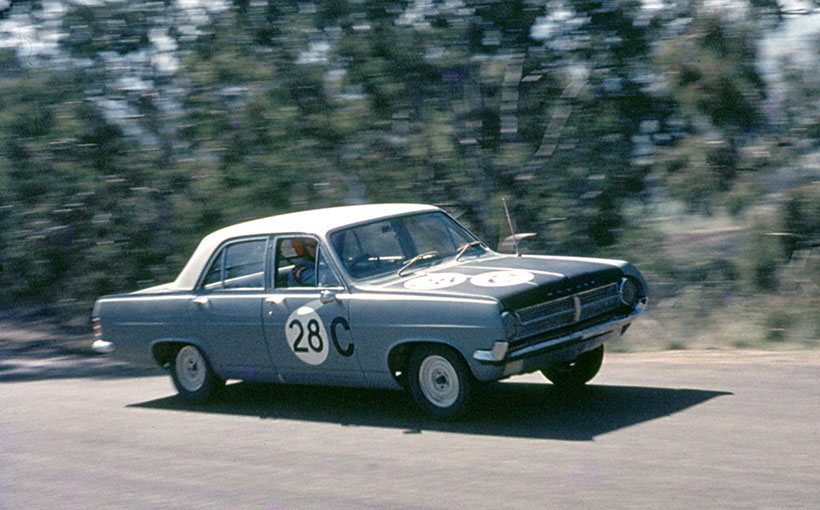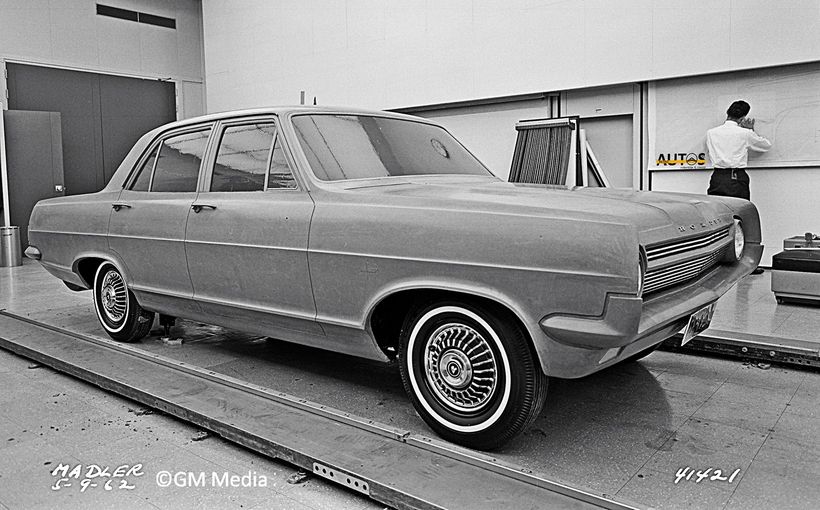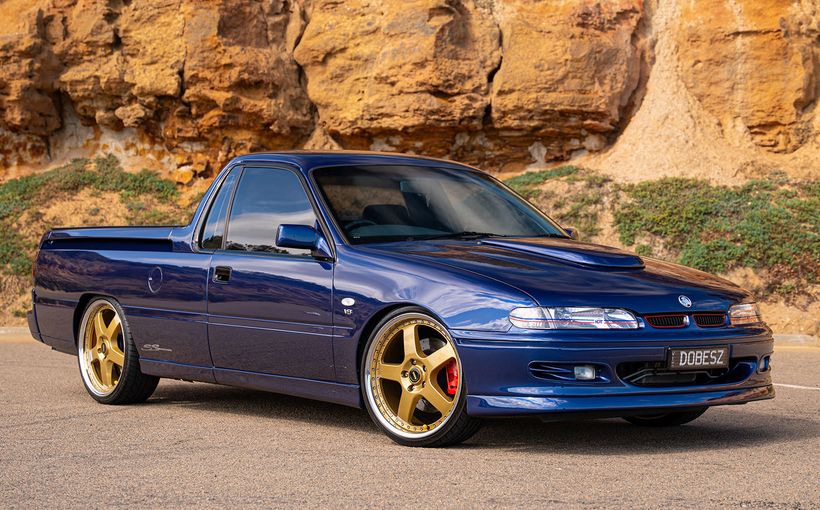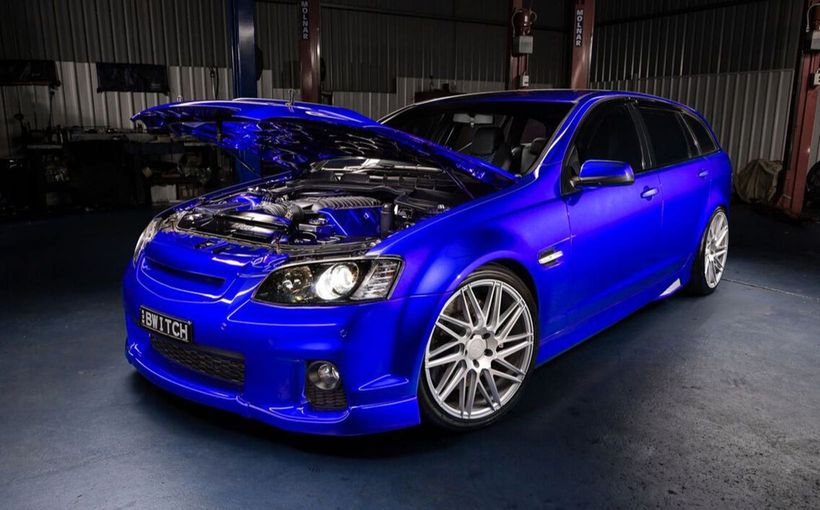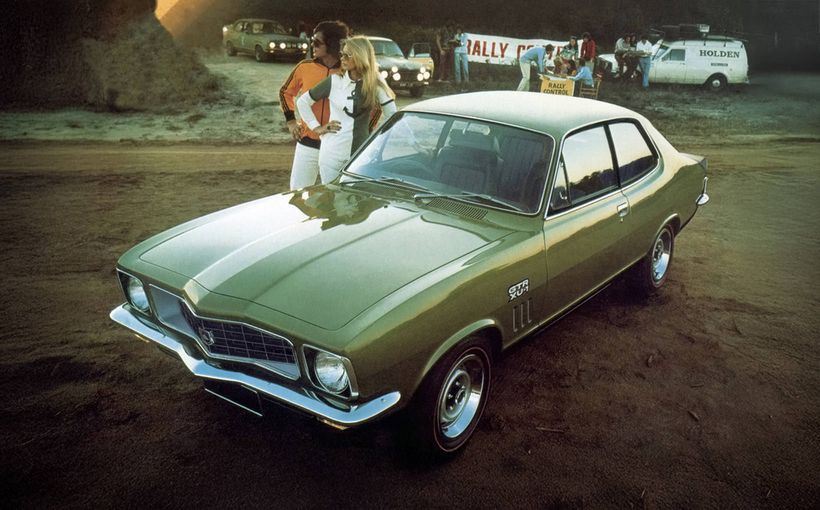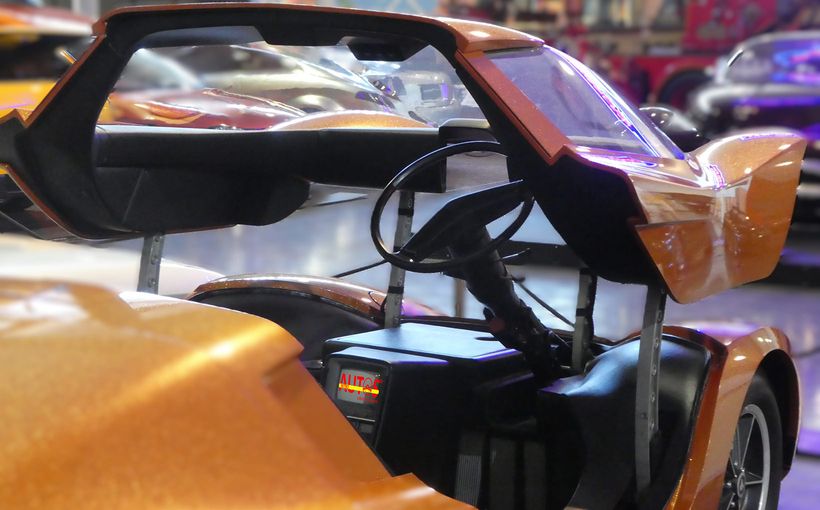HD/HR Holden X2: The General’s mysterious 1960s ’muscle’ car

Holden boasts a rich heritage of special-build high performance road cars that became winning race cars stretching right back to Stormin’ Norm Beechey’s EH S4, which makes the X2 version of the HD and HR models of the mid-1960s an awkward fit in such a stellar line-up.
As a competition car, the stock HD Holden faced an uphill battle from the start given that it shared the skinny track dimensions of the EH and a wheelbase almost as short yet was burdened by a bloated new body style that was heavier and larger than its predecessor in every dimension.
In addition to its extra weight, the major handicap was a higher centre of gravity, which exaggerated the powerful effects of weight transfer resulting in poor handling. The engine was also mounted further forward in the chassis, putting more weight over the skinny drum-braked front wheels.
Not surprisingly, the availability of a higher performance twin-carburettor ‘X2’ engine option tied to a three-speed column manual for this lot left Holden racers scratching their heads. Although HD X2s saw competition use in the mid-1960s, including the annual Bathurst 500, they could not emulate the success of the S4.
The marginally improved handling of the HR facelift that followed failed to fire new race track interest in the X2 option, even though it was based on the larger 186 cid (3.0 litre) engine with a slight increase in power.
Although rally ace Bob Watson bluntly describes the HD as “the worst Holden I’ve ever driven” it did enjoy considerable success in X2 form as a rally car along with the HR version, which as you’ll discover grabbed the lion’s share of rally wins in the mid-1960s before being replaced by the 186S.

1965 Armstrong 500
The HD Holden X2 made its Bathurst debut in the 1965 Armstrong 500, two years after the EH S4 had made its first and only appearance in the Great Race where it finished second to the winning Cortina GT.
The 1965 event gained extra significance as it was the first time in the 500’s history that an outright winner was to be officially recognised, based on the first car to complete the 500 mile (800 km) race distance.
This decision greatly increased the value of the race for car manufacturers, who could see the marketing benefits of being declared the outright winner of Australia’s toughest sedan car race, rather than ‘just’ a class winner.
For a car to be eligible to compete in the 500 in those days, a manufacturer had to produce a minimum of 100 identical, road-registered examples.
With an outright victory now up for grabs, the temptation to build a limited number of ‘Bathurst specials’ proved irresistible for Ford Australia, which commissioned its race and rally contractor Harry Firth to oversee the design and build of the legendary Cortina GT 500.
With a suite of mechanical tweaks designed with Bathurst in mind, including a greatly increased fuel tank capacity, the largely hand-built GT 500 provided Ford with an effective answer to BMC’s new 1275cc Mini Cooper S which was another hot contender for outright honours.

However, anyone holding out for an equally enthusiastic response from Australia’s number one car maker GM-H was to be disappointed. Expectations were high that Holden would continue where it left off with the EH S4 in 1963 by producing a hot ‘Bathurst special’ version of its latest HD sedan released in February that year.
However, there were no signs of the sintered metallic competition brake linings, larger fuel tank or beefed-up transmission and suspension found on the S4. The only hot item on the table was a 140 bhp performance engine option based on the 179 cid (2.9 litre) red six called X2.
For a £48 premium, the budding HD racer got a claimed 25 bhp boost over the stock 179 thanks to twin carbs, a hotter cam, freer flowing exhaust and other tweaks to improve power and durability.
This was tied to a three-speed column manual and short diff ratio.
Of equal importance to potential Bathurst racers was the introduction in June 1965 of a ball-joint front end as a running change across the HD range, to replace the archaic king-pin design from the 1940s - and with that, Holden first front disc brake option.
For a while there, it looked like the new X2 would not be eligible to compete at Bathurst in 1965 as race organiser, the Australian Racing Drivers’ Club (ARDC), initially ruled that the X2 was only a performance option rather than a genuine mainstream model. However, the ARDC reversed its decision, no doubt fearful of favouritism after its approval of Ford’s limited-build GT 500.
The 1965 Armstrong 500 boasted the largest entry yet seen, with works entries from Ford, BMC, AMI (Toyota Coronas) and Datsun to name a few, in a capacity field of 55 cars spread across four classes based on retail prices – Class A up to £920, Class B £921-1020, Class C £1021-1300 and Class D £1301-2000.

Two of the new drum-braked HD X2s were entered, crewed by Lionel Williams and Evan Thomas from Queensland with the other driven by fellow FJ Holden racers Don Smith and Bruce Stewart who both proved to be safe sets of hands that would enjoy great class success at Bathurst in the years to come.
“It was Don’s car and when he first entered it, GM-H rang him up and said he’d better not run it, “ Bruce Stewart told the Shannons Club. “When he asked why, they told him the wheels would fall off! They said the wheels were too thin for racing and the centres would just tear out of them.
“So we told them we were still going to race the car at Bathurst and that Holden was going to look pretty bad if the wheels kept falling off it, so they said they’d think about it and get back to us.
“Anyway, the next minute they delivered us half a dozen wheels that looked the same as the stock ones, only the metal they used to make them was twice as thick! It must have worked because we didn’t have any wheel problems.”
Unfortunately, the chances of a first-up victory in Class C for the Holden X2 were somewhere between Buckley’s and zero, due to retail pricing that grouped it with the extremely rapid Mini Cooper S.
Nine of the ‘flying bricks’ were entered, including three hand-fettled BMC works cars driven by local Mini stars Brian Foley/Peter Manton, plus Monte Carlo Rally winners Paddy Hopkirk/Timo Makinen and a third shared by John French/John Harvey. The other six were private entries. The remaining Class C entries included Cortina GT, Valiant AP5 and a Humber Vogue.

Come race start, as expected the stove-hot 1275cc Minis bolted away into a race-long outright battle with the Cortina GT 500s. The ‘Bathurst special’ Fords would ultimately gain the upper hand and finish first and second outright, due largely to their greater fuel tank capacity which required less re-fills than the potent Minis.
Even so, the Cooper S dominated its class, claiming the first six places in Class C ahead of the lone works-entered Cortina GT. This left the pair of HD Holden X2s in a day-long fight with the 3.6 litre slant six-powered Valiant AP5. The X2 attack was halved, though, when the Williams/Thomas entry broke a wheel in The Dipper (Holden was right!) before its hard-revving six dropped a valve.
This left the Smith/Stewart X2 in a fight for bragging rights with the Valiant. It was a tremendous tussle which went right down to the chequered flag. The almost brakeless AP5 crossed the finish line eighth in class and less than two seconds ahead of the equally brake-challenged Holden, after 116 laps and more than seven hours’ of racing.
“By the end of the race we’d run out of brakes (the front linings weren’t changed during the race) and we’d run out of clutch,” Stewart said. “We’d driven it to death but it was still going. The HD was plenty of fun to drive. It really rocked and rolled around a place like Bathurst but that was fairly typical handling for most cars in the race. I mean, after racing an FJ Holden, anything was good!
“You could set it up with different tyre pressures to dial a fair bit of the understeer out of it because back then you weren’t allowed to do anything else. I think we used to run about 20 psi more in the fronts than the rears to get the thing to turn in and handle a bit better.
“Sitting on a slippery vinyl bench seat was pretty interesting, too, because in those days we were still only using the standard lap-sash belts. Sometimes you’d almost be riding in the passenger seat across Skyline or through The Dipper because you were sliding around so much!”

1966 Gallaher 500
The HD Holden X2 returned to the Mountain for another crack at class honours in the 500, with its entrants no doubt encouraged by the fact the mercurial Mini Cooper S had been moved to another class following the annual price-based shuffle.
With Australia’s recent switch from imperial to decimal currency, the four classes now represented Class A-up to $1800, Class B $1801-2040, Class C $2041-2700 and Class D $2701-4000.
This kept the plethora of Mini Cooper S competitors in Class C, which with the absence of a proposed hotter version of the Cortina GT 500 were destined to dominate both the class and outright battles that year.
The lone HD Premier X2 driven by Mike Savva and Herb Taylor now had a realistic chance of class victory if the cards fell their way, against an eclectic Class D mix that included Triumph 2000, the fast but fragile Studebaker Lark, plus two pairs of Bathurst newcomers in the form of Volvo’s 122S and the lusty 273 cid VC Valiant V8.
In those simpler times the starting grid was still formed in order of the classes, with the most expensive and generally most powerful cars (Class D) logically starting at the front. Practice times showed that the big V8 Studebaker and the VC Valiant V8s would be setting the Class D pace, so the smaller capacity X2 would need to be driven hard and fast to maintain the pressure.

When the starter’s flag dropped on Sunday October 2, the Savva/Taylor X2 made a good start to be in third place behind the leading Studebaker and Valiant V8 as the huge 55-car field roared across the top of the Mountain on the first of 130 laps.
The early leaders soon began to slip down the order, though, as they came under ferocious attack from angry swarms of Mini Cooper S’s, which had started behind them but were now passing from all directions in their frantic multi-car battle for the race lead.
The Class D clash soon became a gripping struggle between the Studebaker Lark and the two Valiant V8s, with Savva and Taylor in the X2 nipping at their heels and waiting to capitalise on any mistakes or mechanical failures amongst the more powerful V8s.
The first crack appeared in the early afternoon when the Studebaker suddenly lost second gear and fell back. This left the two Valiants in the lead of Class D, until they were passed by the Holden X2 during their final fuel stops.
With about 20 minutes’ of the race remaining, the V8 Valiants had caught up again and according to race reports were “hammering on the boot” of the X2 until its engine blew up in a huge cloud of smoke at top speed on Conrod Straight. No doubt things were getting a little stressed under the bonnet at that stage!
The two VC Valiant V8s stormed past to score a resounding 1-2 in Class D ahead of the reliable but outgunned Triumph 2000 in third and Volvo 122S in fourth. The X2, despite its engine failure while leading, was fifth in class and had covered enough laps to be classified a finisher with 118 of the 130 laps completed.

1967 Gallaher 500
The last Bathurst appearance for the HD X2 was in 1967; the same year that saw the arrival of Ford’s thundering ‘Mustang-bred’ XR Falcon GT that would change the face of the Bathurst race.
It was also the first year that grid positions were decided by lap times recorded during practice sessions rather than class order.
Another first was the expansion from four to five classes, to reflect Australia’s rapidly changing car market. These were Class A-up to $1800, Class B-$1801-2100, Class C $2101-3000, Class D $3001-4500 and the new Class E for cars over $4500.
Having come close to a class win the previous year, the HD X2 was now making its third attempt.
It was also starting to look a bit outdated, as the HD had been replaced by the new HR model range more than a year before in April 1966.
The HR continued to offer the high performance X2 engine option, only now in the larger 186 cid capacity with power increased to 145 bhp. Even so, no one chose to enter an HR X2 at Bathurst.
Under the new class structures, the HD X2 found itself in familiar territory; back in Class C and reluctantly reunited with a dozen Mini Cooper S’s again.

Although the lone X2 driven by Herb Taylor and Don Smith could not match the pace of the agile BMC machines, the Holden was considered a reasonable chance against the best of the rest which comprised a quartet of new Fiat 124 sedans, a pair of Prince Skylines and an XR Falcon V8 automatic being trialled by police to determine its suitability for Highway Patrol duty.
The form guide was looking pretty right after practice with the X2 proving faster than all the Fiats and Skylines, clocking a time that placed it 27th in a capacity field that had grown from the previous limit of 55 cars to a new record of 60 starters.
Sadly, that was as good as things got for the X2. After only three race laps, it was the first car to head for the pits with thick clouds of steam puffing from under the bonnet. The cause? The engine moved so far forward on its rubbery mounts when Taylor had to jump hard on the brakes that the fan lunched the radiator!
After lengthy repairs, the X2 returned to the track managed to complete 75 of 130 laps by race end. Thus the X2 was granted the dubious honours of being the only Holden at Bathurst in 1967 and the last classified finisher in 48th place.
The fact that two of Ford’s new Falcon GTs were in first and second places outright when the chequered flag fell was not lost on Holden management and beleaguered fans.
A year later, how things had changed. With the arrival of the breathtaking HK Monaro GTS 327 muscle car in 1968, the General’s earlier efforts at Bathurst were soon forgotten.

Rally Champs!
Holden rally crews had enjoyed considerable success with cars like the EH S4 and 179 manual sedans in the early 1960s so it was a natural progression when the HD and HR X2 sedans followed in their wheel tracks.
At the time, even though General Motors and its many far flung global divisions had a blanket ban on factory involvement in motor ‘racing’, events like reliability trials and rallying were tolerated.
Thus the ‘Holden Dealers Trials Team’ was established, which according to former GM-H employee and HDTT driver Bob Watson was based at GM-H’s service garage at Fishermen’s Bend.
In those days before the Australian Rally Championship (ARC) was conceived, the HDTT’s activities were concentrated mainly on the Victorian Rally Championship, with the enthusiastic support of local Holden dealers including Preston Motors, Bib Stillwell Motors and Bill Patterson Motors.
“Although GM-H gave support to dealerships and teams in other states to do what they wanted to do, the rally cars that were built and serviced at Fishermen’s Bend were only for the Victorian championship,” Watson told the Shannons Club.

“Ford was running a comprehensive rally program with its Falcons in the 1960s as a way of proving that the car was rugged enough for Australian conditions and all that, so Holden just had to become more heavily involved.”
With the launch of the HD Holden X2 in 1965, it was soon being prepped for rally work with the HDTT in Victorian events and crewed by top drivers including Tony Roberts, Mal McPherson and future ARC champion Bob Watson.
In NSW rallying, Holden X2s also thrived thanks to the efforts of enthusiastic Holden dealer Pat Cullen who backed the Holden taxi-driving Garard brothers, John and Greg.
Mal McPherson finished second outright to a works-entered Cortina GT in the gruelling BP Rally in the HD X2’s first Victorian outing and it wasn’t long before the combined efforts of Holden teams in Victoria, NSW, Queensland and Western Australia started winning the majority of events.

“We tried those sintered iron brake linings that came from America (as fitted to S4) but they were bloody awful, because they had no effectiveness at all when they were stone cold but the hotter they got the more effective they became,” Watson said.
“So in the end you only had to look at the brake pedal and the bloody wheels would all lock up and it would usually be a different wheel locking up each time. It made life extremely exciting on gravel I can tell you! We ended up going back to a more conventional lining.
“The HD was a poor handling car so you just had to wrestle with it all the time with the bad brakes and everything. It understeered very badly and with its high centre of gravity and narrow track, it was the worst Holden I’ve ever driven."

When the HD X2 was joined by the better handling and larger capacity 186 cid HR X2 in April 1966, the X2s started to pile on the wins which Holden’s marketing department was able to exploit with a plethora of press advertising that drove home the message about Holden’s rugged durability to counter Ford’s efforts.
Holden’s 1966 rally scorecard was emphatic. Greg Gerard won the NSW Rally Championship in his HD X2, ending a long run of successes enjoyed by Barry Ferguson’s VW. John Flood won the WA title in his HR X2, Tony Roberts claimed the Victorian crown and Ross Farmer finished equal first in the the Tasmanian championship using a combination of hot EH and HR sedans.
Holden’s emphatic 1966 result created a great deal of interest in rallying across the board, from manufacturers and importers to dealers and spectators. As a result the 1967 season promised even greater brand participation and tougher competition for the Holden boys.

Even so, John Flood continued to win some big events in WA, along with Greg Gerard who strung together a number of top four results even though an outright win proved elusive that season.
With Bob Watson heading overseas for the year, the remaining Victorian team drivers Tony Roberts and Reg Lunn were joined by Ron Phillips in another strong X2 attack. Lunn was in sparkling form, repeating his team-mate Roberts’ fine efforts the previous year in winning the 1967 Victorian championship.
The Holden HD/HR X2’s reign soon came to an end with the release of the HR Holden 186S in August 1967 which Holden teams switched to en masse. The X2 though had proven itself to be a worthy champion in the toughest of all motor sports.
Protect your Holden. Call Shannons Insurance on 13 46 46 to get a quote today.

